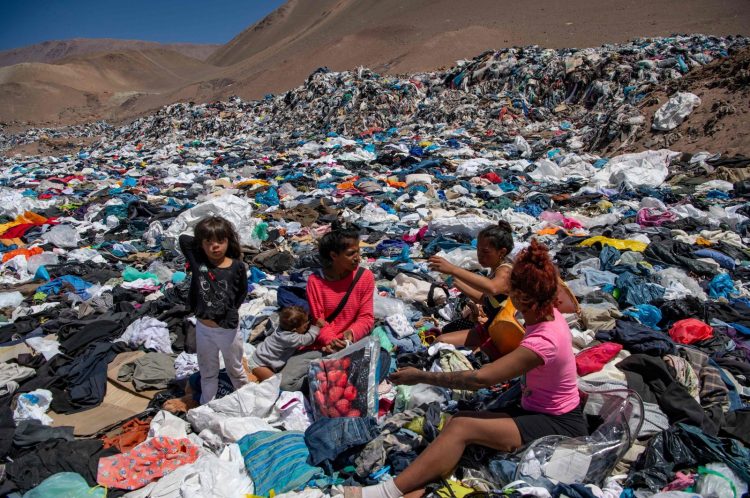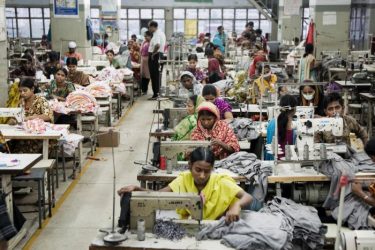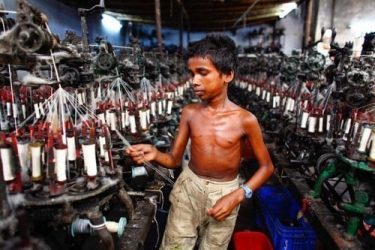May 23, 2023
Address the effects of fast fashion by cultivating a sustainable wardrobe

Women search for usable clothes amid tons of discarded items in Chile’s Atacama desert — famous as a fast fashion dumping ground — in Alto Hospicio, Iquicio, Chile in September 2021 (AFP)
We all make choices about the apparel, shoes and accessories we buy, based on factors such as price, stylishness or trendiness, durability, function and seasonality. And those choices—which the fashion and advertising industries work very hard to influence—have tangible consequences for both the labor force and the finite natural resources needed to create those items.
Fashion is one of the biggest industries in the world, accounting for 2% of global Gross Domestic Product. While that may not initially sound like a lot, consider the numbers: globally, people consume about 80 billion new pieces of clothing every year—an increase of 400% from over just two decades.
But we don’t seem to need all those things: in the U.S. alone, approximately 11 million tons of textile waste is discarded each year, with the UK, Australia and other developed countries not far behind. What’s worse, the fashion industry is also now one of the biggest polluters in the world—second only to oil.
At the same time, the fashion industry has a spotty record on human rights for its more than 40 million garment workers worldwide. Approximately 85% of garment workers are young, female, and from poor rural backgrounds. Many millions of garment workers are children.
The reason for all this waste and human exploitation? Fast fashion, which is a term for mass produced, low-cost, highly profitable clothing designed to reflect current trends in society or inspired by high-fashion designs.
Read: Driven to shop: The psychology of fast fashion (Earthday.org)
Natural resource depletion
For every piece of clothing, every pair of shoes, every purse, belt and hat, there is an industry depleting Earth’s resources to create the raw materials needed for garment factories: healthy soil is depleted, fresh water is contaminated, clean air is polluted, waterways and oceans are filled with plastic and toxic sludge, and forests are destroyed.
Consider these facts:
- The fashion industry is responsible for between 4-8% of global greenhouse gas emissions—more than all international flights and maritime shipping
- Clothing is manufactured with highly toxic dyes and heavy metalsthat find their way into clean water streams, rivers and aquifers where they sicken people and animals, harm ecosystems and cause biodiversity loss.
- Synthetic fibers like polyester, nylon and acrylic, favored by many fast fashion brands, are similar to plastic and made from petroleum or other fossil fuels—meaning they could take up to a thousand years to biodegrade. Once these garments are made, sold, and worn a few times, many of them have the same fate: incinerated or off to the landfill.
- Washing synthetic clothing accounts for 35% of all microplastics in the ocean because the fibers break down during the wash cycle. These microplastics were found in the blood of 80% of people tested in a 2022 study in the Netherlands.
- More than 90% of cotton is now genetically modified, using vast amounts of water and chemicals to produce. Cotton production is now responsible for 18% of worldwide pesticide use and 25% of total insecticide use.
- Our collective washing of clothing containing synthetic materials accounts for 35% of all ocean microplastics, and the industry overall is responsible for 20% of all industrial wastewater.
Unlike most major manufacturing industries, which are highly regulated, the fashion industry is almost entirely unregulated.
Exploited labor
In April 2013, the Rana Plaza factory collapse in Bangladesh killed more than 1,100 people and injured another 2,500. Most were female garment workers, many of them—mirroring the industry at large—young and from poor, rural backgrounds.
The horror of the Rana Plaza disaster brought much needed attention to the state of the garment industry, where a lack of public knowledge about factory working conditions and supply chain transparency is endemic.

A garment factory floor in Bangladesh
According to data from Earthday.org, the average garment worker earns barely half the pay they need to reach a decent standard of living. The monthly minimum wage for a Bangladeshi garment worker is equivalent to $75, or less than $3 a day. In fact, of the millions of factory workers around the world, it’s estimated that only two percent earn a living wage. Many garment workers are unable to afford food staples like meat.
Read: Shaming women out of fast-fashion won’t combat sustainability; empowering women will (Harper’s Bazaar)
Today the fashion industry is the second largest contributor (behind forced marriage) to what is called “modern slavery”, an umbrella term encompassing several types of exploitation, including forced labor, human trafficking and forced marriage.
In many cases, workers are recruited by employment brokers who require payment for work in foreign countries, and brokers keep workers’ travel documents as collateral—restricting their freedom of movement and forcing them into modern slavery.
 Child labor is common in the industry, with estimates of the number of child garment workers in the millions.
Child labor is common in the industry, with estimates of the number of child garment workers in the millions.
The Fair Wear Foundation has a list of over 120 brands that have signed up to its code of labor practices, which do not allow for the use of child labor.
Investigations have demonstrated the highly polluted working environments that garment workers endure. Nonprofit investigative group Transparentum has exposed numerous additional abuses in the supply chains of dozens of companies.
What is sustainable fashion?
Sustainable fashion refers to a clothing supply chain that is ecologically and socially responsible, generally rejecting the fast fashion model in favor of sustainable and equitable practices in sourcing, production, distribution, marketing and consumption of textiles.
More and more, conscientious consumers are embracing clothing resale sites like Poshmark and Depop — websites that specialize in helping users buy and sell used clothing —to avoid primary fast fashion consumption entirely.
The Fabricant creates digital clothing that can be superimposed over an image on social media
Increasingly, designers are incorporating new strategies to reduce resource and textile waste and make more sustainable products. For example, some designers are using geometric patterns that use every inch of fabric, while others create new garments out of the leftover pieces from the cutting room floor. Clothing designed to be reversible or adjustable for size is also becoming more popular.
Many people feel individually powerless to change the trajectory of fast fashion’s impact. But there are ways to collectively shop smarter for a more eco-conscious and ethical wardrobe:
- Buy only what you need.
- Recycle or repurpose your old clothing.
- Treat garments and accessories like long-term investments by investing in high-quality, timeless pieces.
- Choose natural materials, such as organic cotton, hemp, bamboo and linen and other environmentally friendly materials.
- Buy second-hand when you’re in the mood for something new (to you). If you’re an online shopper, try ThredUp, Poshmark or Depop.
- Host a swap. Clean out your closet and shop your friends’ cleaned out closets.
- Do your research. Look into the brand you are considering buying to find out their environmental impacts. Check out the site Good on You and a nonprofit called Remake for transparency reports and allocating sustainability scores.
- Rent clothing from Rent the Runway, Armoire or Nuuly.
The potential for real change in the fashion industry—change that is better for workers, the planet, our closets and ultimately our wallets—is possible. But such a change will require each of us to make those hard choices about what we buy and wear.
Nonprofit focus: Zero Waste Washington
 Zero Waste Washington envisions a just, equitable and sustainable future where we all produce, consume and reuse responsibly. The organization promotes seven priority areas: promoting producer responsibility; reducing plastics pollution; encouraging reuse, repair and sharing; removing toxic chemicals; promoting redesign; reducing contamination; and promoting innovation.
Zero Waste Washington envisions a just, equitable and sustainable future where we all produce, consume and reuse responsibly. The organization promotes seven priority areas: promoting producer responsibility; reducing plastics pollution; encouraging reuse, repair and sharing; removing toxic chemicals; promoting redesign; reducing contamination; and promoting innovation.
Among their initiatives and programs, they encourage:
- Shopping local bulk and zero waste shopping.
- Using Washington’s repair economy: tool libraries, community repair organizations, makerspaces, and professional repair shops and services.
- Joining zero waste community groups: Seattle Zero Waste provides a forum for Seattle-area residents to build relationships, collaborate and share ideas for zero waste living in the area.
- Donating to your local reuse store, such as Habitat for Humanity ReStores (nationwide).
You can support the work of Zero Waste Washington (charity code 0315047) with a one-time gift or recurring payroll deduction through the UWCFD!
Contributed by Nicole Reeve-Parker